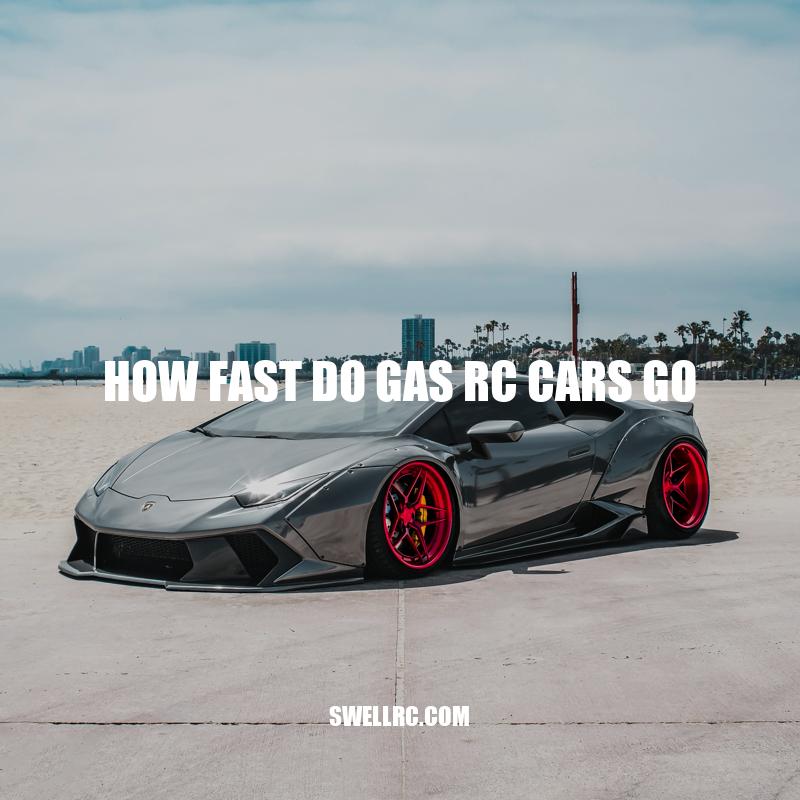How Fast Do Gas RC Cars Go: Factors and Examples
Gas-powered remote-controlled (RC) cars have been a beloved pastime for car enthusiasts of all ages for many years. With the ability to reach high speeds and perform intricate maneuvers, these miniature vehicles offer an exciting and realistic racing experience – but just how fast do they go? The answer to that question varies depending on several critical factors. In this article, we’ll take a closer look at gas-powered RC cars and explore the parameters that can affect their speed. From engine power to gearing ratios, weight distribution, aerodynamics, and track conditions, we’ll provide an in-depth analysis of what separates the fastest gas RC cars from the rest. Whether you’re looking to purchase a new gas RC car or want to optimize the performance of your existing one, understanding the factors that impact its speed can help you get the most out of your racing experience. So sit back, buckle up, and let’s dive into the world of gas-powered RC racing.
Engine power and type
Gas-powered RC cars are equipped with 2-stroke engines that consume a mixture of gas and oil to generate combustion. The horsepower output of these engines can differ depending on the model and tuning. Here are some factors that can impact the speed of a gas RC car engine:
- Engine displacement: The cubic centimeters (cc) displacement of the engine can affect its power output and top speed. Bigger engines can generate more power but also more weight, which can affect handling and acceleration.
- Exhaust system: The design and size of the exhaust pipe can impact the flow of gases and the engine’s ability to expel exhaust quickly. This can affect power delivery and torque.
- Tuning and carburetor: Adjusting the carburetor and other engine settings can fine-tune the engine’s fuel and air mix, which can impact its power band and acceleration.
Some websites and online stores offer a range of gas-powered RC cars with different engine configurations and power levels. Traxxas.com, for example, offers a lineup of nitro-powered RC cars with engines ranging from 2.5cc to 3.3cc displacement and outputting up to 2.8 horsepower. Nitrohouse.com, on the other hand, sells engines and parts from various brands like OS Speed, Ninja, and Team Losi Racing.
How do gas powered RC cars work?
Gas powered RC cars work by using an internal combustion engine that is similar to a real car. Here is how it works:
- Fuel (usually gasoline) is added to the fuel tank.
- The fuel is sucked through the carburetor and mixed with air.
- A spark plug ignites the mixture, causing a small explosion.
- The explosion pushes a piston, which turns the car’s wheels.
Gas powered RC cars are typically faster and more powerful than electric RC cars, but they require more maintenance and are not as environmentally friendly. If you’re interested in purchasing a gas powered RC car, websites such as HobbyKing and Tower Hobbies have a wide selection available.
Drivetrain and gearing
The drivetrain and gearing of a gas RC car can impact how fast it can go, how quickly it can accelerate, and how long it can maintain high speeds. Here are some elements to consider:
- Transmission: Gas RC cars can use a variety of transmissions, including automatic, manual, and single-speed. Each type can affect the car’s torque and speed differently.
- Gear ratio: The ratio between the engine’s output and the rotation of the wheels can be adjusted by changing the size of the gears in the transmission and/or the wheel axle. A shorter gear ratio can improve acceleration but make the car reach its maximum speed faster. A taller gear ratio can increase top speed but reduce acceleration and torque.
- Differential: The differential is a set of gears that allow the wheels to spin at different speeds, which is crucial during turns and corners. The type of differential can affect the car’s handling and traction, as well as its maximum speed.
In general, gas RC cars designed for speed and racing tend to have less weight, more power, and longer gearing, while cars designed for off-road or bashing may have more weight, more torque, and shorter gearing. Here’s a table showing some common gear ratios and their effect on the top speed of a hypothetical gas RC car with a 20cc engine and a 6-inch tire diameter:
| Gear ratio | Top speed (mph) |
|---|---|
| 3.0:1 | 17 |
| 2.5:1 | 20 |
| 2.0:1 | 24 |
| 1.5:1 | 30 |
| 1.0:1 | 40 |
Of course, the actual speed of a gas RC car can vary depending on many other factors, such as the weight distribution, tire compound, track surface, and even the wind. Nonetheless, optimizing the drivetrain and gearing can significantly affect the car’s performance and offer exhilarating speeds for RC enthusiasts.
How Does Gearing Work for RC Cars?
Gearing is an essential component of RC cars. It determines the speed, torque and power of the vehicle. Here’s how gearing works for RC cars:
- The gear ratio determines how fast or slow the RC car will go. It is the ratio between the number of teeth on the motor gear and the number of teeth on the main gear.
- A low gear ratio (fewer teeth on the motor gear) results in more torque and slower speed, while a high gear ratio (more teeth on the motor gear) results in more speed and less torque.
- Different types of RC cars require different gear ratios based on their size, weight, and purpose.
If you’re looking to upgrade or change the gearing on your RC car, check out online hobby stores like Horizon Hobby or Tower Hobbies for a wide variety of gears and gear ratios.
Weight and aerodynamics
The weight and aerodynamics of a gas RC car can also impact its speed, handling, and fuel economy. Here are some factors to consider:
- Body material: The material and thickness of the car’s body can affect how much air resistance it generates, as well as how robust it is against crashes and impacts. Some common materials for RC car bodies include polycarbonate, ABS plastic, and fiberglass.
- Chassis layout: The way the car’s components are arranged can affect its weight distribution, which in turn influences its stability and cornering. A front-heavy car may understeer, while a rear-heavy car may oversteer.
- Wheels and tires: The size, shape, and tread pattern of the wheels and tires can affect the grip, traction, and rolling resistance of the car. Wider and larger-diameter wheels can improve stability and cornering but may add weight and reduce acceleration.
- Aerodynamic add-ons: Some RC car enthusiasts may add spoilers, wings, or other aerodynamic devices to their cars to improve their downforce, reduce lift, or redirect airflow. However, these additions may also add weight and complexity to the car.
When it comes to weight, a lighter car can generally accelerate faster and reach higher top speeds than a heavier car with the same power and gearing. However, reducing the weight can also make the car more fragile and less stable in windy or bumpy conditions. Moreover, some types of RC racing may have weight and dimension restrictions, which can affect the design choices of the car.
One way to test the aerodynamics and speed of a gas RC car is to use a GPS speedometer or telemetry device that can record its velocity and location during a run. Some popular RC equipment brands that offer such tools include Spektrum, Traxxas, and Horizon Hobby. However, using high-end equipment may not be necessary for casual or beginner-level RC racing, and adjusting the weight and aerodynamics of the car may require some experimentation and trial-and-error.
Do aerodynamics matter on RC cars?
Yes, aerodynamics does matter on RC cars. Here are some reasons why:
- Improved aerodynamics can increase speed and handling on the track.
- A well-designed body can reduce wind resistance and drag, increasing acceleration.
- Gaps and holes in the body can create turbulence, reducing overall performance.
If you’re looking to upgrade your RC car’s aerodynamics, check out websites such as Hot Racing and AMain Hobbies for a variety of body options designed for optimal performance on the track.
Track conditions and setup
The track where you run your gas RC car can significantly affect its performance and speed. Here are some factors to consider when setting up your car for a specific track:
- Track surface: The texture, grip level, and moisture content of the track surface can affect how well the car’s tires grip the ground and propel it forward. Some common track surfaces for RC racing include concrete, asphalt, carpet, sand, and dirt.
- Temperature and humidity: The ambient temperature and humidity level can affect the density and viscosity of the air, which can affect the engine performance and the aerodynamics of the car. Hotter and more humid conditions may require richer fuel ratios to prevent engine overheating.
- Elevation: The altitude and slope of the track can affect the air pressure and density, which may impact the engine’s power output and the car’s speed. Higher altitude can cause engines to run leaner, while downhill accelerations may require lower gearing.
- Suspension and alignment: Adjusting the suspension and wheel alignment of the car can improve its handling, stability, and acceleration on different types of tracks. Stiffer or softer suspension settings can affect how the car transfers weight during turns and bumps, while different camber, toe, and caster angles can affect the tire contact area and steering response.
There are various online resources and forums for RC enthusiasts that provide tips, tricks, and track-specific recommendations for gas RC cars. Some popular websites and communities include RC Groups, RC Universe, and RC Driver. Moreover, some RC car brands offer pre-built or customizable setups that are optimized for specific track conditions, such as Traxxas’ “Race Ready” and Redcat Racing’s “Team Redcat” series. However, tweaking and customizing your own gas RC car setup can be a fun and rewarding aspect of the hobby, and can result in a car that performs optimally under your own driving style and preferences.
Can you turn any car into a track car?
- It is possible to modify any car to perform better on a track, though the extent of modification required will vary depending on the make and model of the car.
- Bolt-on upgrades such as suspension components, brake pads, and tires can provide noticeable improvements in track performance without requiring major modifications.
- For those looking for more extreme performance, significant modifications may be necessary, such as engine swaps or custom roll cages.
- If you’re interested in turning your vehicle into a track car, consult with a professional racing specialist to discuss customization options and to assess the potential performance gains.
For more specific information on track car preparation, check out websites such as Turnology or Grassroots Motorsports.
Real-world examples
The maximum speed that a gas RC car can achieve depends on various factors, including its engine power, drivetrain and gearing, weight and aerodynamics, and track conditions. Here are some examples of how fast different gas RC cars can go in ideal conditions:
- RC dragsters: These are specialized gas RC cars that are designed to excel at straight-line acceleration and top speed racing. Some dragsters can reach speeds of up to 100-180 mph in less than 4 seconds, thanks to their high-power engines, long and narrow chassis, and slick tires.
- RC touring cars: These are street-style gas RC cars that are built for both speed and handling on smooth surfaces. Some touring cars can achieve speeds of up to 70-80 mph on paved tracks, thanks to their low and aerodynamic bodies, tuned exhausts, and precise suspension setups.
- RC buggies and trucks: These are off-road gas RC cars that are designed to tackle bumps, jumps, and rough terrains. Some buggies and trucks can achieve speeds of up to 50-60 mph on dirt or gravel tracks, thanks to their all-wheel drive, larger wheels, and higher ground clearance.
- RC boats and planes: Gas RC cars are not the only ones that can go fast in the RC world. RC boats and planes that use gas-powered engines can also reach impressive speeds of up to 60-100 mph or more, depending on their design and environment.
Note that achieving these speeds requires not only the right equipment and tuning but also a safe and controlled environment and experienced driving skills. Always follow the safety guidelines and regulations set by your local RC club or track, and wear protective gear if necessary. Additionally, some websites or online stores that sell gas RC cars, such as Tower Hobbies or Horizon Hobby, offer customer reviews and videos that can give you an idea of what to expect in terms of speed and performance for different models.
How fast can a gas RC car go?
Gas-powered RC cars can reach high speeds, depending on their size, weight, and engine power. Here are some estimated top speeds for different types of gas RC cars:
- 1/10 scale: 30-40 mph
- 1/8 scale: 40-50 mph
- 1/5 scale: 50-60 mph
It’s important to note that the speed of a gas RC car can also be affected by the terrain, weather conditions, and driver skill. If you’re interested in purchasing a gas RC car or learning more about RC cars in general, check out websites such as HorizonHobby.com, TowerHobbies.com, and RCPlanet.com.
Conclusion
In conclusion, the speed of gas RC cars can vary depending on several factors, including engine power, gearing, weight, aerodynamics, and track conditions. Whether you’re a casual hobbyist or a competitive racer, understanding how these variables interact can help you optimize the performance of your gas RC car and enjoy the thrill of speed. Remember that going faster is not always better, and that safety should always be your top priority when operating an RC vehicle. By following the guidelines and tips presented in this article, you can take your gas RC racing experience to new heights and have fun in the process. Happy racing!



